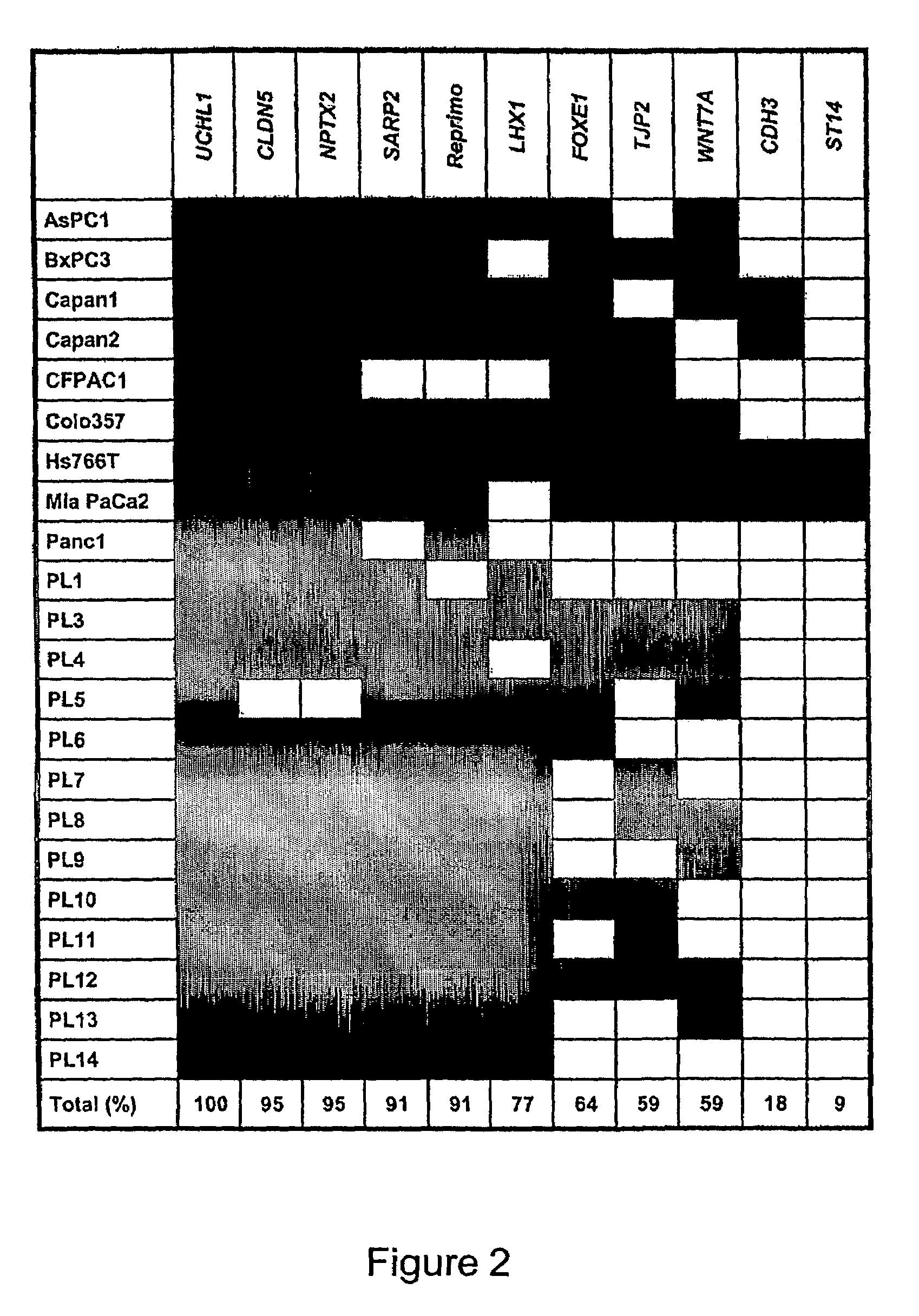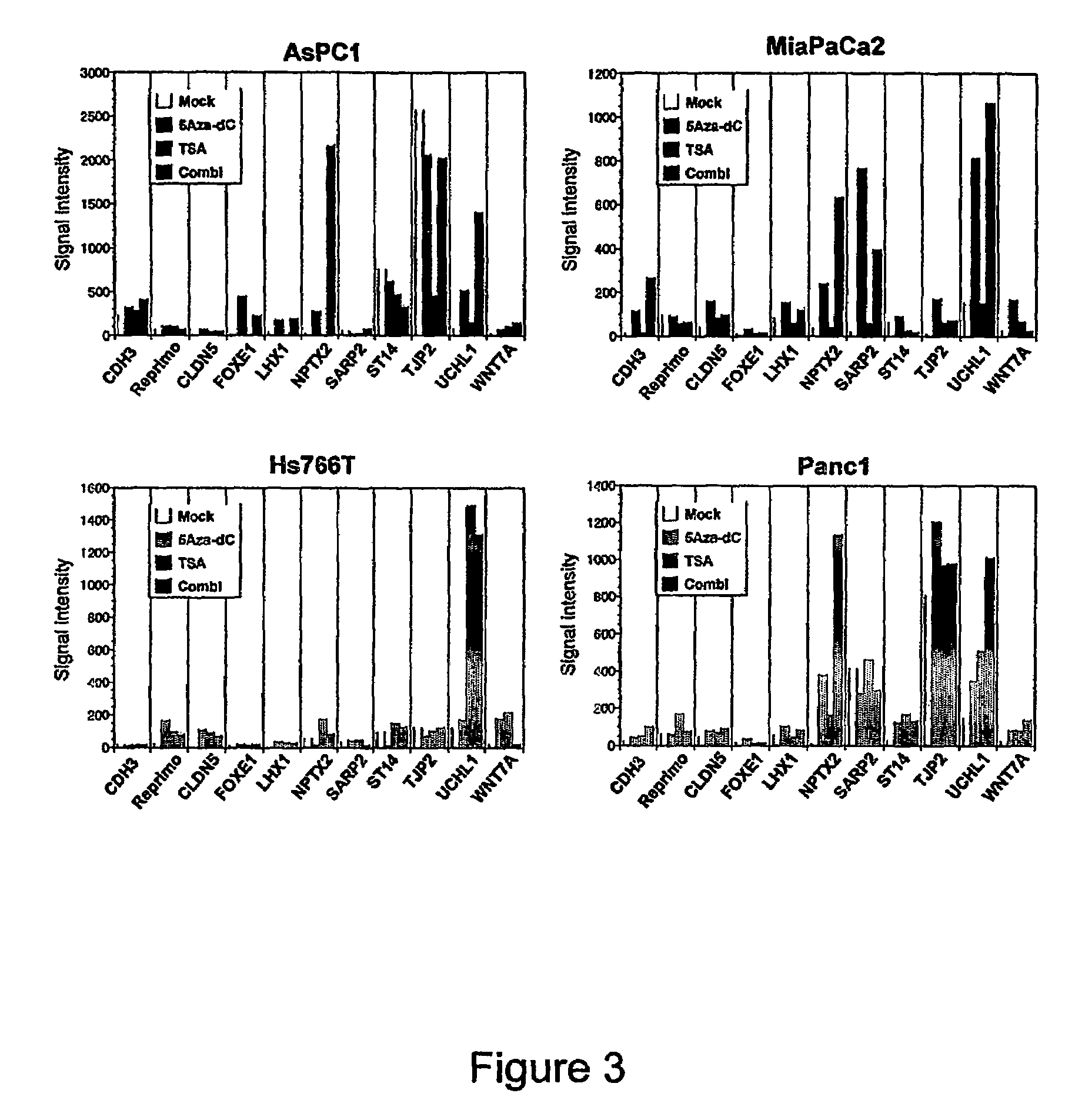Aberrantly methylated genes in pancreatic cancer
a pancreatic cancer and gene methylation technology, applied in the field of gene expression regulation, can solve the problems of the precise role of abnormal dna methylation in human tumorigenesis has not been established, and it is not well understood whether this global aberrant methylation is effective. , to achieve the effect of increasing the likelihood of finding genes methylated in a particular cancer, increasing the sensitivity and specificity of methylation
- Summary
- Abstract
- Description
- Claims
- Application Information
AI Technical Summary
Benefits of technology
Problems solved by technology
Method used
Image
Examples
example 1
Materials and Methods
A. Collection and Preparation of Pancreatic Cell Lines
[0119]Twenty-two human pancreatic cancer cell lines and immortal cell line derived from normal human pancreatic ductal epithelium (HPDE; provided by Dr. Ming-Sound Tsao, University of Toronto, Toronto, Ontario, Canada) were used in this study. Primary pancreatic carcinoma tissues were obtained from surgical specimens resected at The Johns Hopkins Medical Institutions and microdissected to enrich neoplastic cellulairity as described in Ueki, Cancer Res., 60:1835-1839, 2000; Ueki, Cancer Res., 61:8540-8546, 2001). Normal pancreatic duct epithelial cells were selectively microdissected from resected pancreata from 10 patients (mean age, 64.3 years; range, 36-83 years) with various pancreatic disorders using a laser capture microdissection system. Pancreatic juice samples were collected from 37 patients (mean age, 62.9 years; range 31-81 years) undergoing pancreaticduodenectormy for pancreatic ductal adenocarcino...
example 2
Identification of Genes Induced by 5Aza-dC in Pancreatic Cancer Cell Lines
[0126]The global changes in gene expression profiles induced by 5Aza-dC in four pancreatic cancer cell lines (AsPC1, Hs766T, MiaPaCa2, and Panc1) were determined using the Affymetrix U133 oligonucleotide microarrays with 18462 probes sets (transcripts) covering over 13000 full-length sequences of known genes. Compared with mock-treated counterparts, 5Aza-dC treatment resulted in a substantial increase (>5-fold) in signal intensities of 225 transcripts (1.2% of the 18462 trancripts analyzed) in AsPC1, 167 transcripts (0.9%) in Hs766T, 251 transcripts (1.4%) in MiaPaCa2, and 116 transcripts (0.6%) in Panel. The gene expression changes in nonneoplastic ductal cell line HPDE treated with 5Aza-dC identified 101 transcripts (0.5%) whose expression was induced after drug treatment. Forty-one transcripts that were also reactivated in the nonneoplastic HPDE cell line were excluded from the 631 candidates to identify ge...
example 3
Identification of Genes Induced by TSA in Pancreatic Cancer Cell Lines
[0128]The global changes in gene expression profiles induced by the histone deacetylase inhibitor TSA in the same four pancreatic cancer cell lines were analyzed. Treatment with TSA resulted in a marked induction of 424 transcripts (2.3% of the 18642 transcripts analyzed) in AsPC1, 349 transcripts (1.9%) in Hs766T, 207 transcripts (1.1%) in MiaPaCa2, and 459 transcripts (2.5%) in Panc1. Overall, 1196 transcripts (6.5%) including 965 genes and 231 expressed sequence tags were induced 5-fold or greater by TSA in one or more of the four pancreatic cancer cell lines. These include a large panel of novel targets for silencing by histone deacetylation including several known tumor suppressor genes or cell cycle-regulatory genes (ING1, p57KIP2, CHES1, CHFR, GADD45B, and others). Many of the genes induced by TSA treatment were also induced by 5Aza-dC treatment alone, suggesting a role for both DNA methylation and histone ...
PUM
| Property | Measurement | Unit |
|---|---|---|
| pH | aaaaa | aaaaa |
| temperatures | aaaaa | aaaaa |
| temperature | aaaaa | aaaaa |
Abstract
Description
Claims
Application Information
 Login to View More
Login to View More - R&D
- Intellectual Property
- Life Sciences
- Materials
- Tech Scout
- Unparalleled Data Quality
- Higher Quality Content
- 60% Fewer Hallucinations
Browse by: Latest US Patents, China's latest patents, Technical Efficacy Thesaurus, Application Domain, Technology Topic, Popular Technical Reports.
© 2025 PatSnap. All rights reserved.Legal|Privacy policy|Modern Slavery Act Transparency Statement|Sitemap|About US| Contact US: help@patsnap.com



